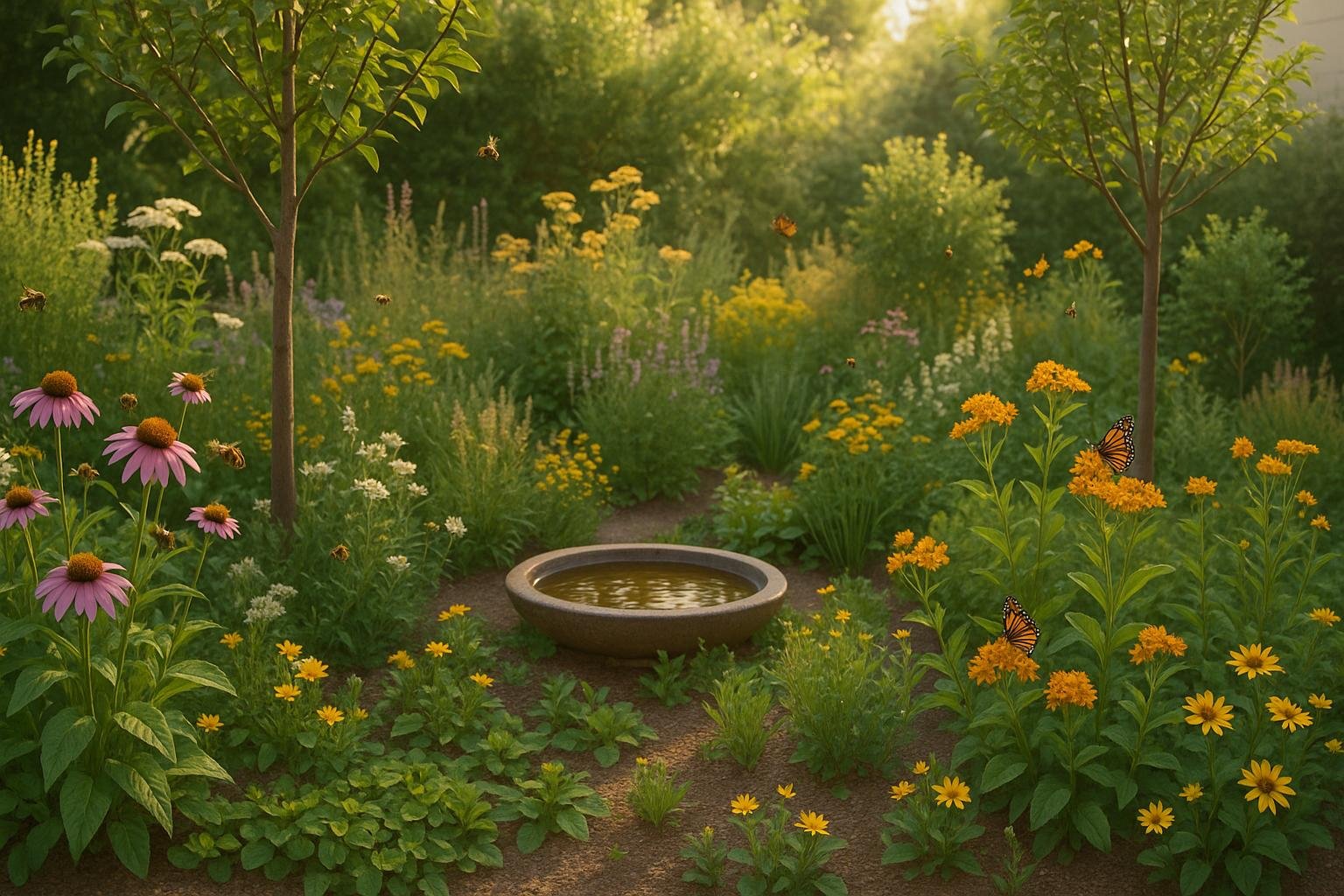Checklist for AI-Driven Biodiversity Planning

Creating a garden that supports biodiversity is easier than ever with AI tools. By combining your goals with data about your garden’s conditions, AI can help you design, plant, and maintain a space that thrives naturally. Here’s how:
- Set clear goals: Focus on supporting pollinators, using native plants, and improving soil health.
- Assess your garden: Map sun exposure, test soil health, and document existing plants and wildlife.
- Use AI tools: Platforms like AIGardenPlanner analyze your garden photos to recommend plants and layouts tailored to your needs.
- Choose the right plants: AI suggests native species, drought-tolerant options, and plants that bloom year-round to support wildlife.
- Maintain with AI: Smart systems monitor plant health, optimize watering, and create care schedules based on your garden’s unique conditions.
AI simplifies biodiversity planning, making it accessible for everyone to create gardens that benefit both nature and their community.
AI Tools for Addressing Conservation and Biodiversity

Set Biodiversity Goals and Check Your Garden
Before diving into AI tools, take a step back to define your goals and assess the state of your garden. Clear objectives make it easier for AI to provide actionable and tailored recommendations for your space.
Set Your Biodiversity Goals
Start by identifying goals that align your personal preferences with the needs of your local environment. For example, you can support pollinators by planting at least three species that bloom during spring, summer, and fall. Pollinators are essential - they sustain more than 70% of flowering plants and play a key role in food production [4][7].
You can also create habitats by incorporating features like host plants, windbreaks, water sources, and even deadwood [5]. These elements provide shelter and resources for various species.
Native plants should also be a priority. They’ve adapted to local conditions, often requiring less water, fertilizer, and pest control, while offering the best support for native wildlife [6]. Plus, they help maintain the balance of your local ecosystem.
Healthy soil is the foundation of a thriving garden. Strong plants grow from living, nutrient-rich soil, which in turn supports more wildlife. To improve soil health, consider adding organic matter and avoiding excessive chemical use. These practices boost soil fertility and structure, making it a better environment for plants and microorganisms alike [3].
A well-thought-out biodiverse garden can even serve as an educational tool, showing your community the importance of pollinators and native ecosystems [3]. Once your goals are clear, you’ll be better equipped to evaluate your garden and make adjustments.
Check Your Garden's Current State
A thorough understanding of your garden’s current conditions is key to making informed decisions. By assessing your space, you can uncover opportunities for improvement and help AI tools provide more precise recommendations.
Start by mapping your garden’s sun exposure and identifying microclimates. Tools like a rain gauge can help you track moisture levels and understand how your garden interacts with its environment [17][14][13].
Next, take a closer look at your soil. You can measure its health by counting earthworms in a 1-foot square, dug 6 inches deep - healthy soil should contain about 10–15 earthworms per square foot. Test the soil’s pH and nutrient levels in both spring and late summer for a complete picture [15][16]. Though not always visible, soil microbes play a huge role in helping plants absorb nutrients [8][11].
Document the plants and wildlife already present in your garden. Evaluate the vertical layers, from ground covers to trees, to ensure a variety of habitats [10][12]. Visual surveys for birds, insects, mammals, and amphibians can provide insight, while tools like camera traps or acoustic monitors can capture activity you might miss [10].
Lastly, examine the balance between predators, prey, producers, and decomposers. A thriving ecosystem depends on maintaining the right mix of these roles [9]. By combining these observations, you’ll have the information needed to tailor AI recommendations and design a garden that meets your biodiversity goals.
Design Your Garden with AI Tools
With clear goals and detailed garden data, AI can turn your gardening dreams into actionable plans. These platforms assess local conditions to suggest plant species and layouts that are both visually appealing and environmentally beneficial [18]. This creates a strong starting point for selecting plants that promote biodiversity.
Upload Photos and Create Garden Designs
Using tools like AIGardenPlanner, you can transform your outdoor space into a biodiversity-friendly garden. Simply upload a clear photo of your yard, and the AI will analyze your current landscape. It examines existing features, sun exposure, and spatial relationships to provide tailored recommendations [19].
From there, you can choose a garden style that aligns with your biodiversity goals. Options include native wildflower gardens, pollinator-friendly designs, or layered planting approaches [19]. With over 50 garden styles to pick from, including ones designed to support local ecosystems, AIGardenPlanner offers something for every vision.
The platform’s AI Plant Advisor takes it a step further by recommending plants suited to your location, climate, and preferences. Whether you want plants that bloom throughout the season or species that provide winter shelter for birds, you can add specific prompts to customize your design [19]. The result? A garden that thrives while supporting wildlife.
Pick Layouts That Support Wildlife
Once your AI-assisted design is ready, you can refine the layout to create habitats that encourage wildlife. These tools excel at optimizing plant placement to balance beauty with ecological function, ensuring your garden works in harmony with nature [18].
A layered planting approach - combining groundcovers, shrubs, and canopy trees - creates diverse habitats for various species. AI can help you visualize how plants will grow over time, avoiding overcrowding while maximizing ecological benefits.
AI suggestions can also guide you in planning layouts that are both efficient and practical. For instance, you can design dense plantings for wildlife while maintaining pathways for easy garden maintenance [19].
Consider adding wildlife corridors - connected plantings that allow animals to move safely through your garden. AI tools can pinpoint the best spots for these features while keeping your design cohesive. They can even suggest locations for water features, brush piles, or nesting areas, ensuring these elements blend seamlessly into your overall aesthetic.
🚀 Ready to Reinvent Your Garden?
Join thousands of homeowners who have transformed their gardens using our AI design tool. Upload one photo to explore endless possibilities.
Get your AI garden designs →Select Plants That Support Biodiversity
Once you've crafted your AI-driven garden design, the next step is choosing plants that can sustain local wildlife throughout the year. AI tools make this task easier by analyzing your garden's specific conditions and recommending plant species that enhance ecological health.
Get AI Plant Suggestions
Modern AI platforms dive deep into factors like weather patterns, soil quality, and climate trends to provide planting suggestions tailored to your garden's needs. For instance, in December 2024, Green.org highlighted how AI tools analyze a mix of weather forecasts, historical climate data, and soil conditions to deliver highly accurate planting recommendations [20].
AIGardenPlanner's AI Plant Advisor takes this a step further by using your zip code, climate zone, and biodiversity goals to suggest plants that thrive locally. It considers key factors like drought tolerance and seasonal bloom cycles, while also incorporating future climate projections. This ensures that the plants you choose are not only suited to your garden now but will also adapt to changing conditions [21].
According to Green.org, "AI promotes biodiversity by identifying the best strategies to encourage diverse plant and animal life in gardens. Through data analysis, it finds patterns that support thriving ecosystems." [20]
Locally adapted species should be your top priority, as they play a critical role in supporting native wildlife. AI algorithms can pinpoint the species that match your soil type and sunlight exposure, making the selection process more effective.
For pollinator-friendly gardens, AI tools can recommend flowering plants with staggered bloom times. This ensures that bees, butterflies, and other beneficial insects have a continuous food source throughout the growing season.
Add Different Types of Plants
Creating a layered planting design can mimic natural ecosystems, and AI tools are excellent at helping you choose plants with varying heights and growth patterns. Start with groundcovers to provide shelter for insects, then add shrubs for bird nesting areas, and finally, include canopy trees to support larger species.
Select plants that offer resources year-round. For example, choose species that provide nectar in spring and summer, and fruits, seeds, or shelter in fall and winter. This ensures your garden remains a haven for wildlife in every season.
AI tools can also guide you toward natural plant partnerships. For example, companion planting suggestions might include aromatic herbs that repel pests while attracting beneficial insects or nitrogen-fixing plants that improve soil health for their neighbors. Additionally, AI can recommend plants with complementary root depths, which helps reduce competition and maximizes soil use.
Given the shifting climate, drought-tolerant plants are becoming increasingly important. AI tools can identify native species that conserve water while still supporting local wildlife. These selections are particularly valuable in maintaining a resilient garden under changing environmental conditions.
Lastly, focus on plants that serve multiple purposes within your ecosystem. AI can help you find species that not only provide nectar for pollinators but also act as host plants for butterfly larvae. This approach allows you to boost biodiversity and create a garden that's both functional and visually cohesive.
sbb-itb-4d6a8dd
Maintain Your Garden with AI Help
Once your biodiverse garden is thriving, you can rely on AI tools to help maintain it. These tools monitor plant health and create care schedules tailored to your garden's unique needs, ensuring the balance you've worked hard to achieve stays intact.
Track Plant Health with AI
AI can spot plant health issues early, achieving over 95% accuracy for common species - far surpassing the 60–70% accuracy of human experts [22][25].
For instance, on February 22, 2025, researchers from Waseda University and Ryukoku University introduced "Plant Doctor", an AI system designed to assess the health of urban trees. Using video footage, this system employs advanced machine vision algorithms like YOLOv8 and DeepSORT, paired with DeepLabV3Plus for image segmentation. It can quantify leaf damage and identify areas affected by bacteria, pests, or fungi.
Smart sensors further enhance monitoring by continuously tracking soil and environmental conditions. These sensors feed data into AI systems, enabling them to predict potential issues before they worsen [23].
You can also use your smartphone to photograph plants showing signs of trouble. AI-powered apps analyze these images instantly, diagnosing pests or diseases and suggesting effective treatments.
Additionally, AI can perform soil analyses to detect nutrient deficiencies. Based on these findings, it recommends the precise type and quantity of fertilizer needed, helping you avoid over-fertilization, which could disrupt your garden's delicate ecosystem [2].
All this information can be integrated into a proactive maintenance plan, ensuring your garden stays healthy and balanced.
Use AI Maintenance Schedules
AI doesn't just monitor plant health - it also helps you plan and manage garden care. By analyzing factors like climate, soil type, sunlight, and the specific plant species in your garden, AI tools create personalized care schedules [2]. Unlike generic advice, these schedules adapt to local weather and seasonal changes.
For example, automated watering systems connected to AI adjust in real time based on soil moisture levels and weather forecasts. This ensures each plant gets the right amount of water, which is especially important in biodiversity gardens where different species have varying needs. AI also suggests organic fertilizers that support soil health [2][22].
Platforms like AIGardenPlanner take this a step further by creating customized care calendars based on your plant selections and local conditions. These calendars send reminders for tasks like watering, fertilizing, pruning, and more, taking the guesswork out of garden maintenance.
AI also helps with fertilization planning, offering guidance on setting up compost systems to reduce waste and enrich your soil. Seasonal tasks, such as pruning after flowering or preparing nesting areas, are also part of these AI-generated schedules, keeping your garden vibrant and functional year-round.
Another major benefit is real-time problem-solving. AI systems can analyze sensor data or photos of plant symptoms to determine if immediate action is needed, allowing you to address issues promptly [24].
Perhaps the most powerful aspect of AI-driven maintenance is its ability to learn. Over time, as it tracks your garden's performance and outcomes, the system becomes even better at predicting its needs and offering suggestions. This continuous improvement not only boosts plant health but also enhances biodiversity in your garden.
Review Results and Plan Ahead
Creating a biodiverse garden is just the beginning. To truly support local wildlife and adapt to changing conditions, regular evaluation is key. This is where AI can play a big role, helping you refine your garden design and make smarter decisions based on data.
Use AI Data to Make Improvements
AI tools are incredibly effective at identifying trends and predicting how biodiversity might evolve in your garden. By feeding your observations into an AI system, you create a feedback loop that sharpens decisions about plant selection and garden layout.
These systems analyze a wide range of environmental data to uncover trends that might not be obvious at first glance. For example, AI can use satellite imagery to track species' habitats and predict changes over time [1]. When applied to your garden, this technology can highlight which areas are thriving and which might need extra care.
A great example of this is Project Guacamaya, which uses AI to analyze satellite and acoustic data for biodiversity monitoring. The project has achieved over 80% reliability in tracking species [26].
"By converting sounds from nature into measurable data, AI helps monitor wildlife populations and track changes in ecosystems."
- Zhongqi Miao, AI for Good Lab's lead bioacoustics research scientist [26]
You can apply similar techniques in your garden. Upload photos of wildlife, record bird calls, and track flowering patterns. AI tools can process thousands of these inputs, spotting patterns you might miss [1]. Platforms like AIGardenPlanner can take this data and offer updated plant recommendations tailored to your garden’s unique conditions.
AI can also help you predict biodiversity outcomes before making major changes, giving you a clearer idea of how your efforts will impact your garden’s ecosystem.
Record and Share Your Results
To make the most of AI insights, combine them with good old-fashioned record-keeping. Keeping detailed notes on your garden’s progress allows AI systems to learn from your specific conditions and provide even better suggestions over time.
Document wildlife sightings, plant growth, and seasonal changes. Pay attention to details like which flowers bloom the longest, which plants attract the most pollinators, and how weather impacts your ecosystem. This data helps fine-tune your garden and ensures that AI recommendations are as accurate as possible.
"By using AI, we can make better conservation decisions before it's too late."
- Tanya Berger-Wolf, Director of the Translational Data Analytics Institute and Professor at Ohio State [1]
The need for this approach is urgent - global wildlife populations have dropped by 70% since 1970 [26]. Sharing your garden’s progress can inspire others to take action and create their own wildlife-friendly spaces.
AI systems can also turn your records into visual data, showing progress, resource use, and biodiversity forecasts [27]. By contributing your observations, you’re not just improving your garden - you’re also helping refine recommendations for other gardeners in different climates and conditions [27].
Consider starting a digital journal with monthly photos, wildlife counts, and notes on what’s working well. Over time, AI-powered apps can analyze this data and turn your observations into actionable strategies, ensuring your garden continues to thrive.
Conclusion
AI tools are transforming the way we approach creating biodiverse gardens, making the process easier and more effective. With the help of this checklist, you’ve seen how technology can simplify planning while supporting local wildlife.
The process starts with setting clear biodiversity goals and understanding your garden’s current condition. Platforms like AIGardenPlanner make this step effortless by analyzing photos you upload and offering tailored plant recommendations. Instead of relying on guesswork, you get precise, data-backed suggestions designed to enhance your local ecosystem.
AI doesn’t stop at planning - it also streamlines garden design and upkeep. From optimizing watering schedules to spotting pests early and customizing fertilization, these tools make maintenance more efficient while directly supporting conservation efforts [2].
The broader impact of AI in conservation is already making waves. For instance, CAPTAIN (Conservation Area Prioritisation Through Artificial INtelligence) has shown it can outperform traditional tools like Marxan in up to 77% of cases, reducing species loss by an average of 9 to 18% [29]. Now, this powerful technology is available to home gardeners in accessible formats.
"AI tools may offer the opportunity to better understand what is happening in the natural world - and how we can conserve it." - Adam Thompson, Global Sustainable Finance and ESG Offering Leader at IBM Consulting [28]
Beyond your garden, the benefits of AI extend to understanding larger ecosystem dynamics. By tracking changes in your garden and sharing your results, you contribute to a bigger movement in conservation. Regularly reviewing data helps refine your garden’s design and ensures its long-term success [30].
What’s more, AI is now affordable and easy to use. For example, AIGardenPlanner offers a Pay As You Go option for just $15, giving gardeners access to professional-grade tools without breaking the bank. From planning to ongoing care, AI simplifies every step, turning your garden into a thriving, wildlife-friendly space. Together, these gardens form a network of habitats that make a real difference for local ecosystems.
🎨 Visualize Your Dream Garden Today!
Transform any outdoor space into a professional landscape design in minutes. Just upload a photo, choose your style, and let our AI do the rest.
Start your garden transformation now →FAQs
How can AI help me choose the best plants to support biodiversity in my garden?
AI takes the guesswork out of choosing plants for your garden by analyzing key factors like your local climate, soil type, and surrounding ecosystem. It pinpoints native species and suggests plants that draw in pollinators, support helpful insects, and create a balanced, thriving habitat.
By customizing recommendations based on your garden’s specific conditions and your personal preferences, AI helps your garden flourish while boosting biodiversity in your area.
How can I prepare my garden for AI-based planning?
Before diving into AI tools for garden planning, it's important to lay the groundwork to get the best results. Here’s what you should do:
- Measure your garden space: Take note of the dimensions in feet or inches. Pay attention to any special features like slopes, shaded spots, or areas with poor drainage.
- Know your environment: Look into your local climate, including average rainfall and seasonal temperature patterns. Test your soil to figure out if it’s sandy, clay-based, loamy, or a mix of these.
- Define your goals: Decide what you want to grow - whether it’s colorful flowers, fresh vegetables, or low-maintenance native plants. Also, consider how much time and effort you’re willing to spend on garden upkeep.
These steps ensure that AI tools can provide recommendations tailored to your space, climate, and gardening ambitions, helping you create a thriving outdoor haven.
How can AI tools help keep my garden healthy and support biodiversity?
AI tools are becoming invaluable for keeping your garden healthy and encouraging biodiversity. With advanced image recognition and predictive analytics, these tools can spot pests, diseases, and signs of plant stress early. This means you can take action right away, giving your plants a better chance to thrive.
Beyond that, AI can keep an eye on soil conditions, suggest the best watering schedules, and even recommend environmentally friendly fertilization methods tailored to your garden. By automating these tasks, AI not only saves you time and effort but also helps you maintain a garden that's both vibrant and eco-friendly.
Related posts
Related Articles

Ultimate Guide to Zen Garden Water Feature Care
Maintain the serenity of your Zen garden water feature with essential cleaning, seasonal care, and troubleshooting tips for lasting beauty.

Revolutionizing Outdoor Spaces: AI Garden Design Tools and Techniques
Discover the benefits of integrating AI in garden design, explore free AI garden design tools, and learn how to leverage AI for efficient and creative landscaping. Find out how AI is reshaping the future of outdoor spaces!

10 DIY Eco-Friendly Christmas Garden Decorations
Create beautiful, eco-friendly Christmas garden decorations using natural and recycled materials to celebrate sustainably this holiday season.

Spring Garden Planning Checklist: Essential Steps for Success
Prepare your garden for spring with essential steps, including soil testing, tool maintenance, and planting schedules for a thriving season.

How AI Improves Microclimate Through Canopy Design
Explore how AI enhances garden canopy design to optimize microclimates, improve temperature control, and conserve water effectively.

5 Solutions for Common Garden Design Challenges
Explore innovative solutions for common garden design challenges, from vertical gardens to AI-driven soil improvements and weather-smart planning.